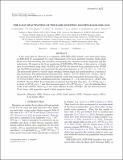Por favor, use este identificador para citar o enlazar a este item:
http://hdl.handle.net/10261/237550COMPARTIR / EXPORTAR:
 SHARE SHARE
 CORE
BASE CORE
BASE
|
|
| Visualizar otros formatos: MARC | Dublin Core | RDF | ORE | MODS | METS | DIDL | DATACITE | |

| Campo DC | Valor | Lengua/Idioma |
|---|---|---|
| dc.contributor.author | Borghese, Alice | es_ES |
| dc.contributor.author | Coti Zelati, Francesco | es_ES |
| dc.contributor.author | Rea, Nanda | es_ES |
| dc.contributor.author | Esposito, Paolo | es_ES |
| dc.contributor.author | Israel, Gian Luca | es_ES |
| dc.contributor.author | Mereghetti, S. | es_ES |
| dc.contributor.author | Tiengo, Andrea | es_ES |
| dc.date.accessioned | 2021-04-10T11:16:53Z | - |
| dc.date.available | 2021-04-10T11:16:53Z | - |
| dc.date.issued | 2020 | - |
| dc.identifier.citation | Astrophysical Journal Letters 902(1): L2 (2020) | es_ES |
| dc.identifier.uri | http://hdl.handle.net/10261/237550 | - |
| dc.description | arXiv:2006.00215v2 | es_ES |
| dc.description.abstract | A few years after its discovery as a magnetar, SGR J1935+2154 started a new burst-active phase on 2020 April 27, accompanied by a large enhancement of its X-ray persistent emission. Radio single bursts were detected during this activation, strengthening the connection between magnetars and fast radio bursts. We report on the X-ray monitoring of SGR J1935+2154 from ~3 days prior to ~3 weeks after its reactivation, using Swift, the Nuclear Spectroscopic Telescope Array (NuSTAR), and the Neutron Star Interior Composition Explorer (NICER). We detected X-ray pulsations in the NICER and NuSTAR observations, and constrained the spin period derivative to $| \dot{P}| \lt 3\times {10}^{-11}$ s s−1 (3σ c.l.). The pulse profile showed a variable shape switching between single and double-peaked as a function of time and energy. The pulsed fraction decreased from ~34% to ~11% (5–10 keV) over ~10 days. The X-ray spectrum was well fit by an absorbed blackbody model with temperature decreasing from kTBB ~ 1.6 to 0.45–0.6 keV, plus a nonthermal power-law component (Γ ~ 1.2) observed up to ~25 keV with NuSTAR. The 0.3–10 keV X-ray luminosity increased in less than 4 days from $\sim 6\times {10}^{33}{d}_{6.6}^{2}$ erg s−1 to about $3\times {10}^{35}{d}_{6.6}^{2}$ erg s−1 and then decreased again to $2.5\times {10}^{34}{d}_{6.6}^{2}$ erg s−1 over the following 3 weeks of the outburst, where d6.6 is the source distance in units of 6.6 kpc. We also detected several X-ray bursts, with properties typical of short magnetar bursts. | es_ES |
| dc.description.sponsorship | This research is based on observations with NICER (NASA), NuSTAR (CaltTech/NASA/JPL) and Swift (NASA/ASI/UK). We thank the NICER, NuSTAR and Swift teams for promptly scheduling our observations. We made use of public Swift and NICER observations asked by the CHIME/FRB collaboration and the NICER team, that we acknowledge. We thank Roberto Turolla and Andrea Possenti for useful suggestions. We acknowledge support from the PHAROS COST Action (CA16214). A.B. and F.C.Z. are supported by Juan de la Cierva fellowships. A.B., F.C.Z., and N.R. are supported by grants SGR2017-1383, PGC2018-095512-BI00, and the ERC Consolidator grant “MAGNESIA” (No. 817661). G.L.I., S.M. and A.T. acknowledge financial support from the Italian MIUR through PRIN grant 2017LJ39LM. G.L.I. also acknowledges funding from ASI-INAF agreements I/037/12/0 and 2017-14-H.O. | es_ES |
| dc.language.iso | eng | es_ES |
| dc.publisher | IOP Publishing | es_ES |
| dc.relation | info:eu-repo/grantAgreement/AEI/Plan Estatal de Investigación Científica y Técnica y de Innovación 2017-2020/PGC2018-095512-BI00 | es_ES |
| dc.relation | PGC2018-095512-BI00/AEI/10.13039/501100011033 | es_ES |
| dc.relation | info:eu-repo/grantAgreement/EC/H2020/817661 | es_ES |
| dc.relation.isversionof | Postprint | es_ES |
| dc.rights | openAccess | en_EN |
| dc.title | The x-ray reactivation of the radio bursting magnetar SGR J1935+2154 | es_ES |
| dc.type | artículo | es_ES |
| dc.identifier.doi | 10.3847/2041-8213/aba82a | - |
| dc.description.peerreviewed | Peer reviewed | es_ES |
| dc.relation.publisherversion | https://doi.org/10.3847/2041-8213/aba82a | es_ES |
| dc.identifier.e-issn | 2041-8213 | - |
| dc.embargo.terms | 2021-10-05 | es_ES |
| dc.contributor.funder | National Aeronautics and Space Administration (US) | es_ES |
| dc.contributor.funder | European Commission | es_ES |
| dc.contributor.funder | Generalitat de Catalunya | es_ES |
| dc.contributor.funder | European Research Council | es_ES |
| dc.contributor.funder | Ministerio de Ciencia, Innovación y Universidades (España) | es_ES |
| dc.contributor.funder | Agencia Estatal de Investigación (España) | es_ES |
| dc.contributor.funder | Agenzia Spaziale Italiana | es_ES |
| dc.relation.csic | Sí | es_ES |
| oprm.item.hasRevision | no ko 0 false | * |
| dc.identifier.funder | http://dx.doi.org/10.13039/501100003981 | es_ES |
| dc.identifier.funder | http://dx.doi.org/10.13039/501100000780 | es_ES |
| dc.identifier.funder | http://dx.doi.org/10.13039/501100000781 | es_ES |
| dc.identifier.funder | http://dx.doi.org/10.13039/501100002809 | es_ES |
| dc.identifier.funder | http://dx.doi.org/10.13039/100000104 | es_ES |
| dc.identifier.funder | http://dx.doi.org/10.13039/501100011033 | es_ES |
| dc.type.coar | http://purl.org/coar/resource_type/c_6501 | es_ES |
| item.openairetype | artículo | - |
| item.languageiso639-1 | en | - |
| item.cerifentitytype | Publications | - |
| item.grantfulltext | open | - |
| item.fulltext | With Fulltext | - |
| item.openairecristype | http://purl.org/coar/resource_type/c_18cf | - |
| Aparece en las colecciones: | (ICE) Artículos | |
Ficheros en este ítem:
| Fichero | Descripción | Tamaño | Formato | |
|---|---|---|---|---|
| thex2154.pdf | 2,25 MB | Adobe PDF |  Visualizar/Abrir |
CORE Recommender
SCOPUSTM
Citations
22
checked on 19-may-2024
WEB OF SCIENCETM
Citations
20
checked on 25-feb-2024
Page view(s)
78
checked on 23-may-2024
Download(s)
42
checked on 23-may-2024
Google ScholarTM
Check
Altmetric
Altmetric
NOTA: Los ítems de Digital.CSIC están protegidos por copyright, con todos los derechos reservados, a menos que se indique lo contrario.
